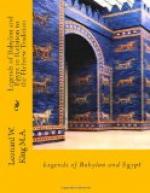In the present case the inference of magical use is drawn from certain passages in the text itself, which appear to be explicable only on that hypothesis. In magical compositions of the later period intended for recitation, the sign for “Incantation” is usually prefixed. Unfortunately the beginning of our text is wanting; but its opening words are given in the colophon, or title, which is engraved on the left-hand edge of the tablet, and it is possible that the traces of the first sign there are to be read as EN, “Incantation".(1) Should a re-examination of the tablet establish this reading of the word, we should have definite proof of the suggested magical setting of the narrative. But even if we assume its absence, that would not invalidate the arguments that can be adduced in favour of recognizing the existence of a magical element, for they are based on internal evidence and enable us to explain certain features which are inexplicable on Dr. Poebel’s hypothesis. Moreover, we shall later on examine another of the newly published Sumerian compositions from Nippur, which is not only semi-epical in character, but is of precisely the same shape, script, and period as our text, and is very probably a tablet of the same series. There also the opening signs of the text are wanting, but far more of its contents are preserved and they present unmistakable traces of magical use. Its evidence, as that of a parallel text, may therefore be cited in support of the present contention. It may be added that in Sumerian magical compositions of this early period, of which we have not yet recovered many quite obvious examples, it is possible that the prefix “Incantation” was not so invariable as in the later magical literature.
(1) Cf. Poebel, Hist. Texts, p. 63, and Hist. and Gram. Texts, pl. i. In the photographic reproduction of the edges of the tablet given in the latter volume, pl. lxxxix, the traces of the sign suggest the reading EN (= Sem. siptu, “incantation"). But the sign may very possibly be read AN. In the latter case we may read, in the traces of the two sign-groups at the beginning of the text, the names of both Anu and Enlil, who appear so frequently as the two presiding deities in the myth.
It has already been remarked that only the lower half of our tablet has been recovered, and that consequently a number of gaps occur in the text. On the obverse the upper portion of each of the first three columns is missing, while of the remaining three columns, which are inscribed upon the reverse, the upper portions only are preserved. This difference in the relative positions of the textual fragments recovered is due to the fact that Sumerian scribes, like their later Babylonian and Assyrian imitators, when they had finished writing the obverse of a tablet, turned it over from bottom to top—not, as we should turn a sheet of paper, from right to left. But in spite of the lacunae, the sequence of events related in




